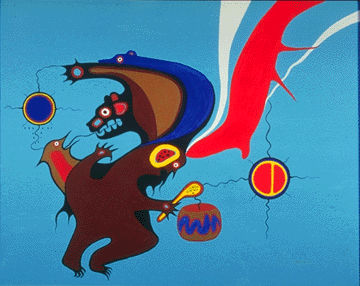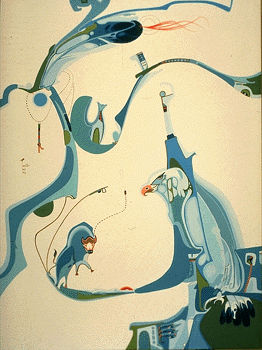Jackson Beardy (also known as Quincy Pickering Jackson Beardy), Oji-Cree artist (born 24 July 1944 in Island Lake, MB; died 8 December 1984 in Winnipeg, MB). Beardy was part of the Woodlands School of Indigenous art, and in 1973 he became part of a group of Indigenous artists popularly known as the Indian Group of Seven. His stylized artworks — sometimes painted on canvas, birch bark or beaver skins — were often concerned with the interdependence of humans and nature. They also tended to depict figures from Ojibwe and Cree oral traditions. From the late 1960s to his death in the early 1980s, Beardy promoted Indigenous art as a valid category of contemporary art. His influence as a Woodland artist has contributed to the development of contemporary Indigenous art in Canada.

Early Life and Education
Jackson Beardy was born to John Beardy and Dinah Monias on Garden Hill First Nation in Manitoba. The fifth of 13 children, he was raised by his grandmother who taught him Cree legends and traditions. (See also Religion and Spirituality of Indigenous Peoples in Canada.)
When Beardy turned seven, he was sent to residential school in Portage la Prairie where he was forced to disavow his native language and heritage. As a result of his experiences at the residential school, Beardy began to consume alcohol as a coping strategy. He developed ulcers due to his drinking, and he gave up alcohol in 1974.
Beardy learned to draw and paint at the residential school, and he eventually went on to study art at the Technical Vocational High School in Winnipeg (1963–64). He completed his formal education at the University of Manitoba (1966). (See also Contemporary Indigenous Art in Canada.)
In the early 1960s, Beardy started to paint images representing the oral traditions of his culture. Sometimes considered taboo, the paintings were not always accepted within his community. However, Beardy’s artistic career took off by the mid-1960s.
Artistic Career
In 1967, Jackson Beardy was invited to travel to Montreal as a consultant for the Indians of Canada pavilion at Expo 67. He also received commissions to produce works of art to commemorate Canada’s centennial in 1967 and Manitoba’s centennial in 1970. At the grand gala for Manitoba’s centennial at the National Arts Centre in Ottawa, Beardy and his family — though invited — were refused entrance by security guards. This experience of discrimination informed Beardy’s dedication to advocating for Indigenous artists and individuals in Canada.
In 1972, Beardy, along with Daphne Odjig and Alex Janvier, held an exhibition at the Winnipeg Art Gallery called Treaty Numbers 23, 287, 1171. The numbers in the exhibition’s title referred to the those given to the artists’ respective bands when treaties had been signed with the Canadian government. The exhibition was curated by Jacqueline Fry (1923–91). The three artists, along with Norval Morrisseau, Carl Ray, Eddy Cobiness and Joseph Sanchez, later formed the Professional Native Indian Artists Incorporation (PNIAI) in 1973, popularly known as the Indian Group of Seven. Their goal was to promote their art in Canada, but more broadly, to have Indigenous art valued for aesthetic reasons rather than as anthropological artifacts. (See also History of Indigenous Art in Canada.)
During the 1970s, Beardy lent his hand to illustrating the book covers of Leonard Peterson’s Almighty Voice(1974), John Morgan’s When the Morning Stars Sang Together(1974) and Basil Johnston’s Ojibway Heritage(1976). In 1980, Beardy moved to Ottawa, and from 1982 to 1983 he was senior arts adviser to the Department of Indian Affairs and Northern Development. While working there, Beardy authored the department’s manual for collecting Indigenous art called “Indian Fine Arts Guide.”
Beardy returned to Winnipeg in 1984. That year he was commissioned by the Family Indian Centre to paint “Peace and Harmony” murals on the southeast corner of Selkirk and Powers, one of the earliest mural sites in Winnipeg. He died before he could complete the project. The murals were completed posthumously by artists at R.B. Russell Vocational High School, and they were unveiled at a ceremony on 5 September 1985 by Manitoba’s Lieutenant-Governor Pearl McGonigal. The north wall envisions peace and harmony amongst humans, which is symbolized by the peace pipe. The west wall represents harmonious exchanges between human beings, the spirit world and nature. In 2006, the murals were repainted and restored by a team led by two of the original students in the Graphic Art class, Sweetpea (Leo Neilson) and Emily Amos. The team worked under the supervision of the Centre’s Director, Jeanet Sybenga.
Did You Know?
A Jackson Beardy painting was presented to Queen Elizabeth II by the Province of Manitoba in 1979.
Key Exhibitions and Collections
Jackson Beardy’s first solo exhibition took place at the University of Winnipeg in 1965. In addition to many other solo exhibitions in the 1960s and 1970s was the exhibition Images for a Canadian Heritage in 1977 in Vancouver, British Columbia. Beardy’s art was also shown at the Winnipeg Art Gallery in 1993–94. A retrospective, Jackson Beardy: A Life's Work, was on display in 1995 at the Thunder Bay Art Gallery in Ontario. He had 17 solo shows.
Group exhibitions included the Indians of Canada pavilion at Expo 67inMontreal and the groundbreaking Treaty Numbers 23, 287, 1171in 1972 at the Winnipeg Art Gallery. The 1976 exhibition, Contemporary Native Art of Canada: The Woodland Indians, was organized by the Royal Ontario Museum in Toronto, and traveled to England and Germany. Contemporary Indian and Inuit Art of Canada, organized by the Department of Indian and Northern Affairs, travelled between 1983 and 1985. Beardy’s work was featured in the first Indigenous exhibition at Rideau Hall in 1983. His art was also displayed in exhibitions at the University of Winnipeg Gallery (2008), the Buhler Gallery, St. Boniface Hospital (2012) and the Mackenzie Art Gallery in Regina (2013–14).
Beardy’s artworks are held in a range of collections, including at the Canadian Museum of Civilization (now the Canadian Museum of History) and the Supreme Court in Ottawa. Outside the nation’s capital, Beardy’s works can be found in Glenbow Museum ( Calgary), Manitoba Museum of Man and Nature (Winnipeg), McMichael Canadian Collection ( Kleinburg), Royal Ontario Museum (Toronto), Simon Fraser University ( Burnaby), University of British Columbia (Vancouver) and the Winnipeg Art Gallery. Internationally, Beardy’s art can be found at Mother Teresa’s Hospital (India), University of Wellington (New Zealand) and Windsor Castle (Great Britain).
Teaching and Advisory Positions
In addition to his work with the federal government in the early 1980s, Beardy served as art advisor and cultural consultant to the Manitoba Museum of Man and Nature. He also taught classes in the Department of Native Studies at Brandon University and at the University of Manitoba.
He was an active member of the National Indian Arts Council, the Manitoba Arts Council, the Prison Arts Foundation, Canadian Artists’ Representation and the Canadian Indian Artist Association. Beardy was also on the Board of Directors for the Manitoba Arts Council.
Death and Legacy
Beardy died at 40, having suffered complications following a heart attack. His 1984 memorial service was the first ever held in the Blue Room of the Manitoba Legislative Buildings. Federal, provincial and civic leaders joined Beardy’s family and Indigenous leaders in and paying tribute to his life and work.
Awards and Honours
- Canada Centennial Medal (1967).
- Young Achievers Award (1974).
- Canada Council Grant (1982).
- Outstanding Young Manitoban Award (1982).

 Share on Facebook
Share on Facebook Share on X
Share on X Share by Email
Share by Email Share on Google Classroom
Share on Google Classroom








